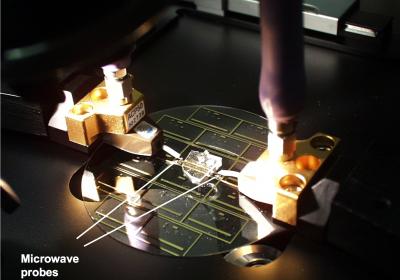Micro-microwaves and Mini-Fuel Cells
Interview with
Chris - Time now to catch up, as we do once a month, with Mark Peplow. He's from Chemistry World. We were talking about microwaves just now and you're talking about a microwave oven which is absolutely excruciatingly tiny?
 Mark - That's right, last week an American Scientist was claiming it's the world's smallest microwave oven. It's shorter than an ant and half as wide as a single human hair. It's a tiny thread of an oven. You could fit a pin head's worth of liquid in it. About a millionth of a litre.
Mark - That's right, last week an American Scientist was claiming it's the world's smallest microwave oven. It's shorter than an ant and half as wide as a single human hair. It's a tiny thread of an oven. You could fit a pin head's worth of liquid in it. About a millionth of a litre.
Chris - People say ready meals are making the population too fat. Maybe we should just give them one of those microwaves because they'd get a microcalorie. What's the point of this?
Mark - Yeah, you wouldn't get much of your evening dinner in this. Essentially this is to create a device where you could heat small amounts of material very easily and very quickly. A good example is if you were doing forensic work out in the field and you wanted to analyse some DNA. One of the ways that people do that is to use a reaction called the polymerase chain reaction. That involves heating and cooling. It actually amplifies your DNA sample so that you can do a test on it. If you imagine a handheld device, it needs a very small heating facility within it. What these guys are proposing is that they can use this microwave oven, tiny as it is, to do this sort of analysis.
Chris - How does it actually work?
Mark - Essentially it's very much like the microwave oven in principle. You have a small cavity hollowed out of a polymer block where your sample goes in and small channels to deliver that liquid into the cavity. You have a very fine tracery of gold wires etched into the polymer block. It's the electrical current moving through those in a particular way that delivers the microwaves.
Chris - Sounds amazing but sticking with the very small, fuel cells are hot topic at the moment.
Mark - Yes, fuel cells are a way of turning chemical energy in a gas like hydrogen into an electrical current. Researchers in Oxford, led by Fraser Armstrong, have created a microscopic fuel cell. They've taken a graphite particle - graphite is the stuff in your pencil - and they've stuck an enzyme on it that converts hydrogen into an electrical current. They've proved that this is working by sticking another enzyme on the other end of the graphite particle which does another reaction. They're saying this is a proof of principle that you can take these sorts of fuel cells, which are already being used in cars and lighthouses, and use them to run chemical reactions in these microscopic test tubes that chemists are working on. So called, 'labs on a chip.'
Chris - Application-wise, you would think people are quite eager to have ways of powering tiny robotic things that you could put inside bodies or do very, very technical things on tiny scales. Energy sources like this must be very important for them.
Mark - That's right. Conventional batteries have proved incredibly difficult to miniaturise in that sense. Conventional battery technology just ends up making very bulky battery packs. Fuel cells are an alternative way you can really shrink things down. You can have a tiny volume of gas that serves as an energy source like hydrogen and this would be the converter to give you a constant current.
- Previous Robot Cars - the DARPA Urban Challenge
- Next Over Everest










Comments
Add a comment